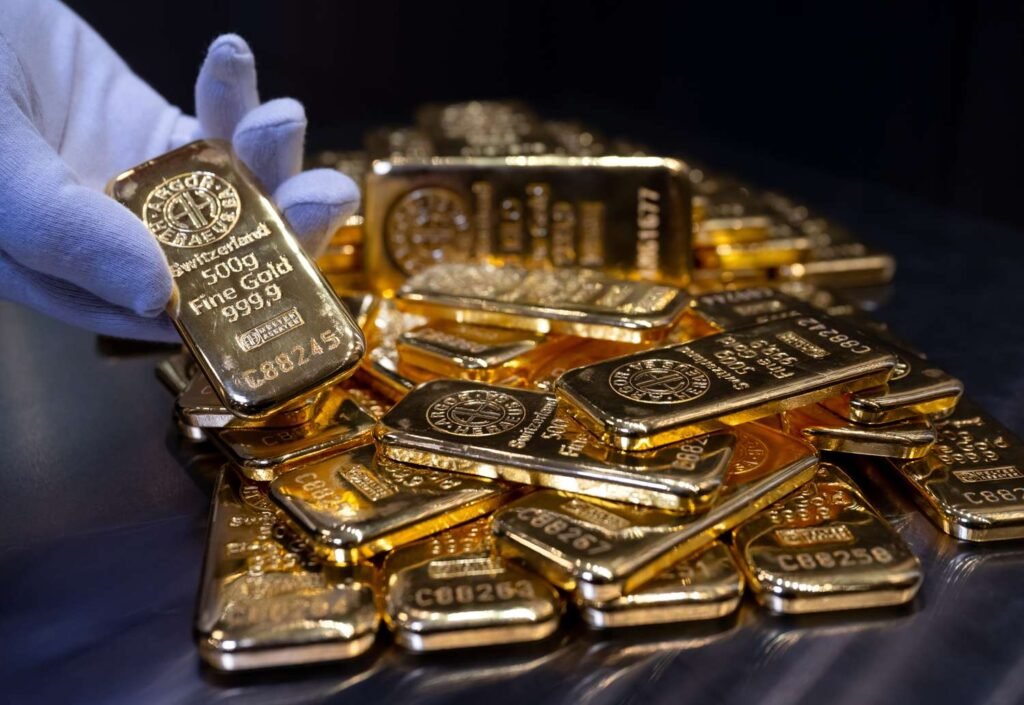:max_bytes(150000):strip_icc():format(jpeg)/GettyImages-2207845067-73d92572c39044bcbd343bf3d238d6a0.jpg)
In uncertain times, some investors try to buy the dip with stocks. Others buy bonds. But when the economy shows serious signs of strain—high inflation, political volatility, or a looming recession—gold tends to steal the spotlight.
After all, it’s been the go-to store of value for centuries. And lately, it’s been living up to that reputation: Over the past year, gold has surged to new all-time highs, with a latest record surpassing $3,500 an ounce in April 2025.
Is gold really the ultimate safe haven in economic storms? Or is it just a shiny distraction from better long-term options? One expert says the truth sits somewhere in between.
Key Takeaways
- Gold’s recent rally has reignited its reputation as a crisis hedge, with returns outpacing the S&P 500 in recent years.
- Advisors say gold offers psychological comfort and portfolio diversification, but they warn against making it a core holding.
- Ultimately, pay attention to the size of your position: Gold might shine in storms, but equities tend to win over long-term horizons.
The Precious Metal’s Golden Era
Gold’s current bull run hasn’t gone unnoticed. In fact, it has quietly outpaced some of the stock market’s biggest benchmarks.
Over the past three years, gold has delivered a compound annual growth rate (CAGR) of about 23%, compared to roughly 15% for the S&P 500 over the same period, said Robert S. Jeter II, the founder of Back Bay Financial Planning & Investments.
“People will tend to flock to it in periods of significant uncertainty,” he said, pointing out that most of gold’s surge has been over the last nine months. “Gold tends to do best as ‘insurance,'” he said.
Today’s investors are responding to a broader range of stressors: geopolitical instability, budget deficits, rate volatility, and fears that U.S. dominance in financial markets could be fading. Amid that turbulence, gold has maintained its place as a tangible and comforting alternative.
Fast Fact
Due to mounting concerns over the rising cost of living and ongoing global uncertainty, affluent investors more than doubled their allocations to gold from 2024 to 2025, according to HSBC.
Why Gold Has Been Hitting Record Prices
Some of gold’s appeal is technical and based on real spreads and market dynamics. But a lot of it is psychological.
“Gold has the tangibility that a stock and bond don’t have,” Jeter said. “I think most people mentally automatically take comfort with that idea.” And in periods of macroeconomic stress, that comfort matters. Unlike equities or corporate bonds, which are tied to business performance and economic cycles, gold exists outside the traditional system. It doesn’t promise dividends, but it doesn’t carry the risk of bankruptcy or missed earnings, either.
Gold’s value lies in its lack of correlation with traditional assets in periods of stress, Jeter says. Investors treat it as a store of value, not because it always outperforms, but because it performs differently. When everything else is falling, gold tends to hold steady—or even rise.
How Gold Compares to Other Safe Haven Assets
Gold isn’t the only refuge in a storm. Bitcoin, often described as “digital gold,” has shown similar behavior during bouts of volatility, and its annualized return over the past 10 years has been an astounding 49%, compared to 10.6% for gold.
“When we went through the last ‘storm’ in April, bitcoin also had some of those same characteristics and acted as a bit of a safe haven,” Jeter said. But he also points out that crypto clearly has a much shorter history to rely on than gold, and experts caution that crypto’s recent returns are unlikely to be repeated in the next decade.
When it comes to historical consistency, gold remains unmatched among safe havens. “It’s hard to argue that gold isn’t a great economic malaise hedge,” Jeter says, citing both its track record and its psychological pull. To compare, the Vanguard Real Estate ETF has a 10-year annualized return of 5.6%, far below gold but above the iShares US Treasury Bond ETF’s return of 1.05%.
However, just because gold is useful doesn’t mean it should dominate your portfolio. “Hedges should not be significant positions,” Jeter said. “Over the next 20 to 30 years, it would be hard to imagine a scenario where gold outperforms equities, and if that were the case, I’d have some concerns about the world we’re living in.”
The S&P’s annualized return over the past 15 years is nearly 17.5%, compared to just 6.5% for gold. The key, he said, is thoughtful diversification. Gold can protect against shocks, but it can’t fuel long-term growth the way stocks can. And over-allocating to any single asset—even a popular one—can backfire.
The Bottom Line
Gold shines brightest in moments of fear and dislocation and acts as a buffer when traditional markets stumble. That makes it a valuable hedge, not a silver bullet.
Gold is a timeless, tangible, and occasionally high-flying investment, but still just one part of a balanced long-term plan.
At the end of the day, Jeter recommends talking to an advisor about the right-sized gold investment for your portfolio, based on your financial goals. Financial planning software can also help simulate various outcomes for different asset classes.

